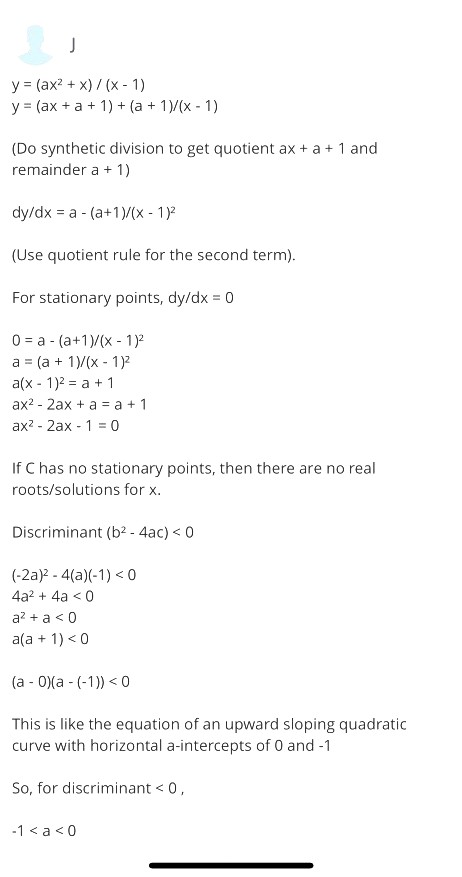Ask Singapore Homework?
Upload a photo of a Singapore homework and someone will email you the solution for free.

Question
junior college 1 | H2 Maths
One Answer Below
Anyone can contribute an answer, even non-tutors.

hello! I need help with this question thanku
y = (ax + a + 1) + (a + 1)/(x - 1)
(Do synthetic division to get quotient ax + a + 1 and remainder a + 1)
dy/dx = a - (a+1)/(x - 1)²
(Use quotient rule for the second term).
For stationary points, dy/dx = 0
0 = a - (a+1)/(x - 1)²
a = (a + 1)/(x - 1)²
a(x - 1)² = a + 1
ax² - 2ax + a = a + 1
ax² - 2ax - 1 = 0
If C has no stationary points, then there are no real roots/solutions for x.
Discriminant (b² - 4ac) < 0
(-2a)² - 4(a)(-1) < 0
4a² + 4a < 0
a² + a < 0
a(a + 1) < 0
(a - 0)(a - (-1)) < 0
This is like the equation of an upward sloping quadratic curve with horizontal a-intercepts of 0 and -1
So, for discriminant < 0 ,
-1 < a < 0
(Alternatively, you can check for the sign of a(a + 1) when a > 0, a < -1 and -1 < a < 0 and see which will give you a negative sign)
y = (ax² + x) / (x - 1)
Differentiate directly using quotient rule.
dy/dx = [(x - 1)(2ax + 1) - (1)(ax² + x)] / (x - 1)²
dy/dx = (2ax² + x - 2ax - 1 - ax² - x) / (x - 1)²
dy/dx = (ax² - 2ax - 1) / (x - 1)²
For stationary points, dy/dx = 0
(ax² - 2ax - 1) / (x - 1)² = 0
Since denominator is non-zero for the expression to be defined, the numerator has to equal 0.
ax² - 2ax - 1 = 0
Subsequently, follow the steps as shown in the previous comment.
y = (ax + a + 1) + (a + 1)/(x - 1)
① There is an oblique(or slant) asymptote y = ax + a + 1.
Compare to the equation of a straight line y = mx + c,
It has gradient a and y-intercept a + 1.
For -1 < a < 0, the line has a negative gradient.
0 < a + 1 < 1
Its y-intercept is positive and between 0 and 1
When y = 0, ax + a + 1 = 0
ax = -a - 1
x = -1 - 1/a
This is the x-intercept.
② Looking at the denominator of the second term, there is a vertical asymptote x = 1
You can go to desmos.com and plot
y = (ax + a + 1) + (a + 1)/(x - 1).
Set a to some value between -1 and 0. You will see the shape to draw. Try to vary the value of a using the slider tool and observe how the shape changes.
You should have two points of intersection with the axes. One has coordinates (0,0) (the origin) and the other (-1/a, 0)
To obtain these coordinates, it is easier to use the original equation y = (ax² + x) / (x - 1)
To solve for intersection with the x-axis, set y = 0
0 = (ax² + x) / (x - 1)
Numerator has to be 0, so ax² + x = 0
x(ax + 1) = 0
x = 0 or x = -1/a
Note that by doing so we have also found the curve's y-intercept (since when x = 0, y = 0)
See 1 Answer





